-
If you need help identifying a pepper, disease, or plant issue, please post in Identification.
You are using an out of date browser. It may not display this or other websites correctly.
You should upgrade or use an alternative browser.
You should upgrade or use an alternative browser.
Anyone know of a Purple Colour Cap. Frutescen
- Thread starter justecila
- Start date
Ok..got yah. Probably is a cross but everything visible in that picture screams C.annuum.
Now that is a legit purple frutescens!!!!!!!! I want that sexy beast!!!!! If you are interested in a trade let me know. Nothing in my stock is off limits for that.justecila said:#Jblo I must agree with Pr0b that the hot Ecuador display Annuum characteristic. This purple suspected Frutescens have flower with Frutescens' character (ie 90 deg bent at its peduncle)
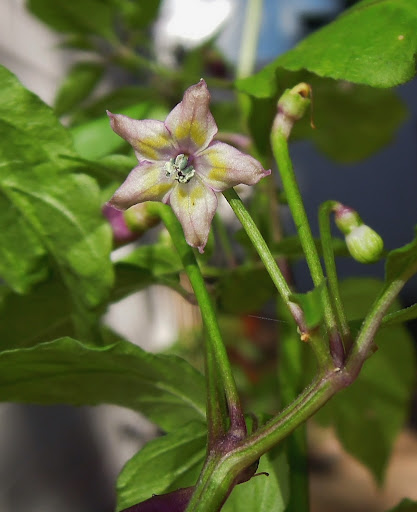
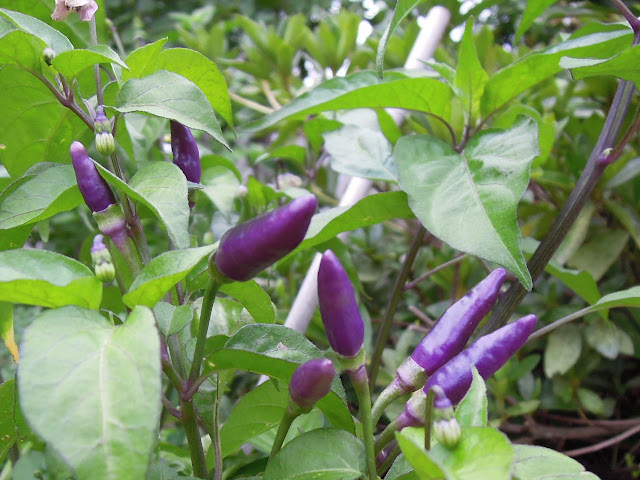
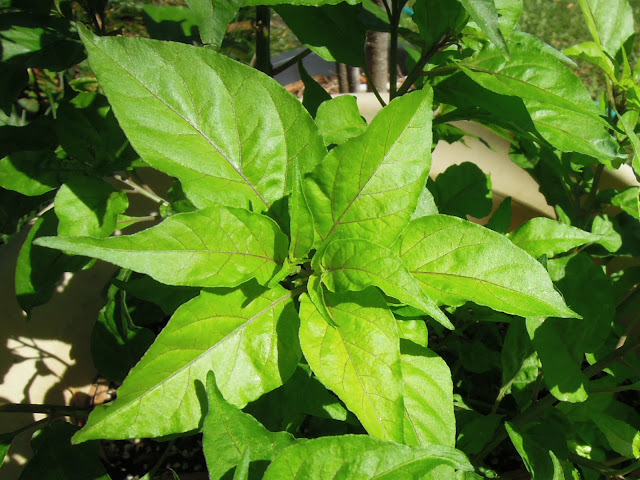
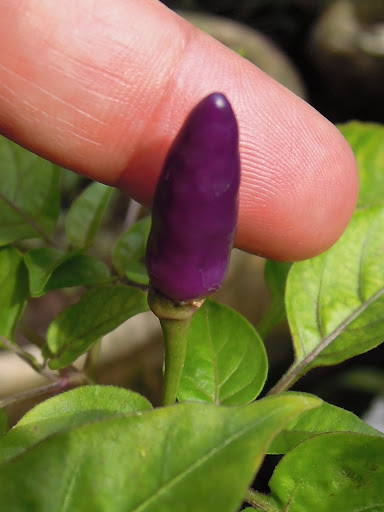
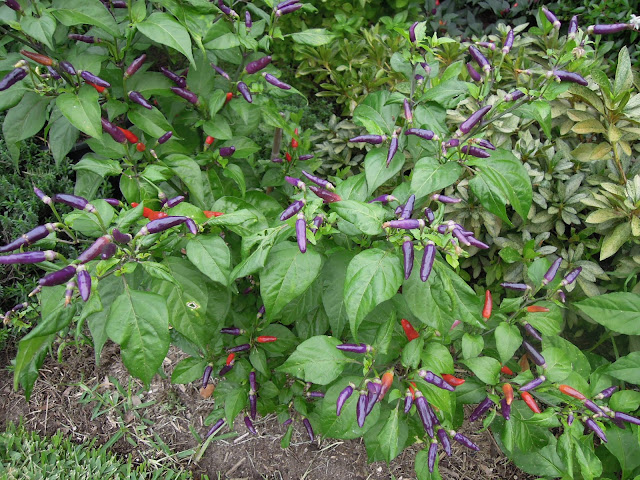
I think I found a purple frutescens plant at a grocery store I would have bought it if I would have known the significance if I go back and there are a couple I can probably send you a plant if you would likePr0digal_son said:Now that is a legit purple frutescens!!!!!!!! I want that sexy beast!!!!! If you are interested in a trade let me know. Nothing in my stock is off limits for that.
Thanks. I have zero room left and I'm still potting up plants. Just planning for next season.Nightshade said:I think I found a purple frutescens plant at a grocery store I would have bought it if I would have known the significance if I go back and there are a couple I can probably send you a plant if you would like
Very few differences in frutescens varieties so a purple one interests me.
That's a beautiful looking pepper plant!
Quite a few annuum have the sheperd's crook pedundle - Goat's Weed, my tepins do it, my Czech Black does it.
I would put my rooster on a block - that is not a frutescens. It even looks like we have some baccatum or such-like in there. But frutescens? Doubt it. Confidently.
It is a beautiful plant though - I am leaning towards a baccatum x annuum.
I would put my rooster on a block - that is not a frutescens. It even looks like we have some baccatum or such-like in there. But frutescens? Doubt it. Confidently.
It is a beautiful plant though - I am leaning towards a baccatum x annuum.
There is no way frutescens genes can be confidently ruled out. I agree,annuums share some similar traits,this plant has more frut traits that annuum and baccatum combined. Location alone almost classifies it. Leaf structure,pinched corolla tips,multiple fruits per node,thin skin with juicy pods that fall off when ripe,etc. I have talked to a couple folks who have grown this and I will quote one of them.RobStar said:Quite a few annuum have the sheperd's crook pedundle - Goat's Weed, my tepins do it, my Czech Black does it.
I would put my rooster on a block - that is not a frutescens. It even looks like we have some baccatum or such-like in there. But frutescens? Doubt it. Confidently.
It is a beautiful plant though - I am leaning towards a baccatum x annuum.
"Skin is thin & ripened pods are soft/juicy & dropped off easily for that cb ungu."
The green/yellow colouration on the flower is also typical of frutescens,although that pattern is odd. I don't see the streaks or spotting of a baccatum. That doesn't rule them out though. I wouldn't rule bacc or annuum out of that mix at all. I just don't know how anyone can confidently rule out C.frut though?
If anything it is a multiple hybrid. C. futescens flowers are small, bordering on tiny. Same with C. chinense.
The foliage of this thing is very C. chinense-like or like some of the more luxuriant C. baccatum (my Aji Amarillo has fantastic foliage not too dissimilar except for colouration). The purple colouration definitely comes from C. annuum. I don't know of any other Capsicum that displays so much foliage variation. I don't know of any other Capsicum that has purple foliage as part of its repertoire.
The markings are from baccatum or the rarely seen eximium. I would feel confident with baccatum as i just don't feel that eximium would easily be involved in a hybrid of this nature (too rare). In any case C. emimium would only only hybridise with C. pubescens and C. baccatum var praetermissum. C. baccatum var praetermissum could account for the soft squishy fruits.....
I'm not ruling C. frutescens out of the mix, just saying it is not a C. frutescens. C. frutescens could well be present - as part of a ménage à trois involving C. baccatum var praetermissum x C. frutescens x C. annuum var aviculare. That is quite a complex hybrid and the chances of it, even in a garden without controlled breeding, is quite unlikely.
I am more in favour of C. baccatum var baccatum x C. annuum var aviculare. That explains the charcters presented and is also a fertile hybrid that would occur quite easily under cultivation.
Whatever it is it is beautiful and worth growing.
The foliage of this thing is very C. chinense-like or like some of the more luxuriant C. baccatum (my Aji Amarillo has fantastic foliage not too dissimilar except for colouration). The purple colouration definitely comes from C. annuum. I don't know of any other Capsicum that displays so much foliage variation. I don't know of any other Capsicum that has purple foliage as part of its repertoire.
The markings are from baccatum or the rarely seen eximium. I would feel confident with baccatum as i just don't feel that eximium would easily be involved in a hybrid of this nature (too rare). In any case C. emimium would only only hybridise with C. pubescens and C. baccatum var praetermissum. C. baccatum var praetermissum could account for the soft squishy fruits.....
I'm not ruling C. frutescens out of the mix, just saying it is not a C. frutescens. C. frutescens could well be present - as part of a ménage à trois involving C. baccatum var praetermissum x C. frutescens x C. annuum var aviculare. That is quite a complex hybrid and the chances of it, even in a garden without controlled breeding, is quite unlikely.
I am more in favour of C. baccatum var baccatum x C. annuum var aviculare. That explains the charcters presented and is also a fertile hybrid that would occur quite easily under cultivation.
Whatever it is it is beautiful and worth growing.
RobStar said:If anything it is a multiple hybrid. C. futescens flowers are small, bordering on tiny. Same with C. chinense.
The foliage of this thing is very C. chinense-like or like some of the more luxuriant C. baccatum (my Aji Amarillo has fantastic foliage not too dissimilar except for colouration). The purple colouration definitely comes from C. annuum. I don't know of any other Capsicum that displays so much foliage variation. I don't know of any other Capsicum that has purple foliage as part of its repertoire.
The markings are from baccatum or the rarely seen eximium. I would feel confident with baccatum as i just don't feel that eximium would easily be involved in a hybrid of this nature (too rare). In any case C. emimium would only only hybridise with C. pubescens and C. baccatum var praetermissum. C. baccatum var praetermissum could account for the soft squishy fruits.....
I'm not ruling C. frutescens out of the mix, just saying it is not a C. frutescens. C. frutescens could well be present - as part of a ménage à trois involving C. baccatum var praetermissum x C. frutescens x C. annuum var aviculare. That is quite a complex hybrid and the chances of it, even in a garden without controlled breeding, is quite unlikely.
I am more in favour of C. baccatum var baccatum x C. annuum var aviculare. That explains the charcters presented and is also a fertile hybrid that would occur quite easily under cultivation.
Whatever it is it is beautiful and worth growing.
C.eximium will cross with c. frutescens. It's speculated this variety is a c. baccatum x c. frutescens hybrid. C. annuum is suspect due to the purple, but it has clear c. frutescens and c. baccatum characteristics. Perhaps it's a 3 way interspecific hybrid.
Yes it will, but the chances of a chance 3 way hybrid involving eximium is very very slender. C. eximium is not exactly common in cultivation. And given that this thing originated in SE Asia where market gardeners are most surely not growing C. eximium, I am more in favour of baccatum x annuum var aviculare.
I am struggling to see any specific frutescens characters in the plant - that can only be attributed to frutescens. I can see baccatum traits and I can see annuum var aviculare traits. But anything specifically attributable to frutescens I do not see.
I am struggling to see any specific frutescens characters in the plant - that can only be attributed to frutescens. I can see baccatum traits and I can see annuum var aviculare traits. But anything specifically attributable to frutescens I do not see.
If you don't see frutescens attributes,what C.glabriusculum attributes do you see? They aren't purple,have similar if not smaller flowers than frutescens,only have one fruit per node,way smaller leaf structure,different calyx,etc.
I agree that eximium is highly unlikely,but what makes you think market gardeners are growing bacc var bacc? And originating in SE Asia,you don't believe it has no C.frut genes? By far the most popular species in that region.
Maybe we are on different pages about what a C.frutescens is. I have grown and done fairly extensive documentation of 8 or 10 varieties.
Take the green streak out of the flower,and the purple tinge and that is a frutescens flower. It may look large in the pictures,but there is nothing there for reference.
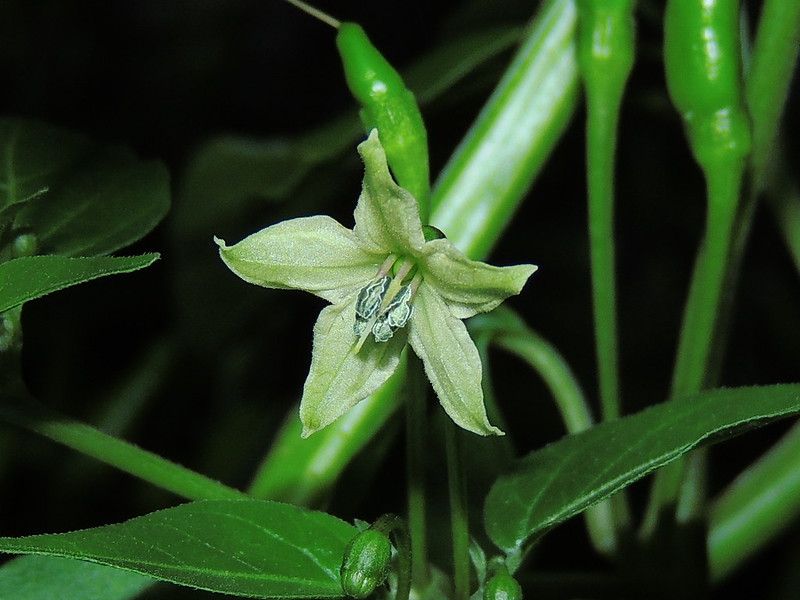
I agree that eximium is highly unlikely,but what makes you think market gardeners are growing bacc var bacc? And originating in SE Asia,you don't believe it has no C.frut genes? By far the most popular species in that region.
Maybe we are on different pages about what a C.frutescens is. I have grown and done fairly extensive documentation of 8 or 10 varieties.
Take the green streak out of the flower,and the purple tinge and that is a frutescens flower. It may look large in the pictures,but there is nothing there for reference.

RobStar said:Yes it will, but the chances of a chance 3 way hybrid involving eximium is very very slender. C. eximium is not exactly common in cultivation. And given that this thing originated in SE Asia where market gardeners are most surely not growing C. eximium, I am more in favour of baccatum x annuum var aviculare.
I am struggling to see any specific frutescens characters in the plant - that can only be attributed to frutescens. I can see baccatum traits and I can see annuum var aviculare traits. But anything specifically attributable to frutescens I do not see.
The calyx, for example, looks like c. frutescens and not c. annuum. I never said it was a c. eximium cross, but I wanted to point out that you can cross c. frutescens with it.
Flowers are the basis of the species concept in botany. Therefore what the flower looks like and its morphometrics are what determines a species or not. The reasoning is simple - only two similar flowers can interbreed and therefore constitute a species. I've really over-simplified it so don't shred it - go and research it for yourself.
Right. So take away this and that and add this and that and voila! it is a frutescens. No can do. It is what it is. We have to evaluate what we have in front of us. It is a purple flower (never recorded in frutescens but quite common in others, including annuum) with markings (not recorded in frutescens but standard in others, including baccatum).
Numerous annuum cultivars display multiple flowers per node. Think Japanese hot claw, Mirasol, Poinsettia, the ornamental Medusa.
The annulus of the calyx is genrally cited as the distinguisihing feature - it can be well-developed or not but generally it is a starting point.
Now let's look at all of this:
The pic is of a plant with an annulus. C. frutescens does not have an annulus. C. annuum does.
The flowers are purple. C. frutescens never has purple flowers. C. annuum does.
The plant has multiple fruit per node. C. frutescens does. So do numerous cultivars of C. annuum.
The flower has markings. C. frutescens does not. C. baccatum amongst others does.
If you want to believe it is a purple frutescens then by all means do so. My last Q is: what is the mature colour of the fruit? I know of no Capsicum that has mature fruit of a colour other than yellow, red, orange, brown or green (selected by man).
Right. So take away this and that and add this and that and voila! it is a frutescens. No can do. It is what it is. We have to evaluate what we have in front of us. It is a purple flower (never recorded in frutescens but quite common in others, including annuum) with markings (not recorded in frutescens but standard in others, including baccatum).
Numerous annuum cultivars display multiple flowers per node. Think Japanese hot claw, Mirasol, Poinsettia, the ornamental Medusa.
The annulus of the calyx is genrally cited as the distinguisihing feature - it can be well-developed or not but generally it is a starting point.
Now let's look at all of this:
The pic is of a plant with an annulus. C. frutescens does not have an annulus. C. annuum does.
The flowers are purple. C. frutescens never has purple flowers. C. annuum does.
The plant has multiple fruit per node. C. frutescens does. So do numerous cultivars of C. annuum.
The flower has markings. C. frutescens does not. C. baccatum amongst others does.
If you want to believe it is a purple frutescens then by all means do so. My last Q is: what is the mature colour of the fruit? I know of no Capsicum that has mature fruit of a colour other than yellow, red, orange, brown or green (selected by man).

